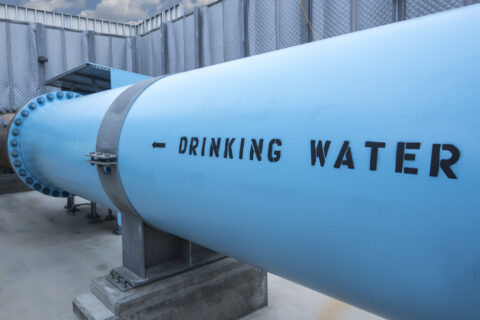Last month, President Biden signed the Inflation Reduction Act into law, marking the largest federal investment in climate and clean energy. With a mix of federal funding and tax credits, the law includes a new mechanism for tax-exempt entities, such as cities, towns and villages, to take advantage of many of the new clean energy tax incentives included in the law. Historically, only taxpaying entities were able to take advantage of renewable energy tax incentives, but this legislation levels the playing field between taxpaying and non-taxpaying entities and opens the door for local governments to access these incentives.
The Inflation Reduction Act includes a provision that provides non-taxable entities participating in clean energy incentives with a direct payment option in lieu of tax credits. This provision is applicable for tax years starting after December 31, 2022 and ending before January 1, 2033. Tax-exempt entities will be able to claim a refund for the excess taxes they paid or deemed to have paid. Effectively, this provision essentially makes the applicable tax credits as “refundable” tax credits. Under the IRA, the amount of the credit will be paid to the tax-exempt entity when they make an election to receive the credit on a tax filing for tax return in the year in which the project is placed in service.
Here are two ways direct payment can be useful to cities, towns and villages.
Clean Commercial Vehicles
Qualified commercial vehicles are one example of how this new direct pay provision could be useful to cities, towns and villages. The Inflation Reduction Act created a new credit for qualified commercial vehicles under Section §45W of the Internal Revenue Code. Section 45W provides a direct pay tax credit that is available to tax-exempt entities for up to 30 percent of the cost of qualified commercial clean vehicles placed in service before 2033. There is a limit of $7,500 for vehicles with a gross weight of less than 14,000 pounds, and $40,000 limit for vehicles at or above that weight.
Watch Now
Webinar participants learned how local governments can take advantage of this new opportunity to help meet their clean energy goals. Content is Member-Gated.
A city, town or village could then utilize this direct pay tax credit when they purchase a qualifying commercial vehicle, place it into service, and file their return, receiving a payment of up to 30 percent of the qualifying purchase with the payment limits applied based on the gross weight of the vehicle. For larger commercial clean vehicles that a municipality may purchase, such as a new fire engine, the larger direct pay tax credit applies to reduce the cost of these purchases. A clean vehicle fire engine’s gross weight would be in excess of 14,000 pounds, which would qualify for the $40,000 tax credit as provided by Section 45W. This would dramatically reduce the cost of purchasing clean vehicles for municipal fleets and help cities, towns and villages make a faster change from gas to electric vehicles.
For more information about the Section 45W Tax Credit, refer to this FAQ document produced by the IRS.
Renewable Energy
The direct pay option also applies to the Production Tax Credit and the Investment Tax Credit, both of which are primary investment credits used to help finance renewable energy projects. Local governments with municipal utilities that finance a clean energy capital project, such as a solar array, with 100 percent tax-exempt debt will be able eligible for the direct pay option in lieu of tax credits for installing such a project in the community.
However, the Inflation Reduction Act stipulates if a project is financed 100 percent with tax-exempt debt, the direct pay amount to the municipality will be reduced by the lesser of (a) 15 percent or (b) the portion of the qualifying project that has been financed with tax-exempt debt. Because this is a “lesser of” test, projects can be financed with 100 percent tax-exempt debt, while only reducing the direct pay tax credit by 15 percent, making the project financed with 100 tax-exempt debt more feasible and appealing to municipalities seeking to use this financing route for clean energy projects.
Through the direct payment provision in the Inflation Reduction Act, local governments have many incentives to invest in clean energy, whether that be through an installation of a clean energy system or purchasing qualifying commercial vehicles. This legislation holds much potential for municipalities across the nation to take advantage of at the start of the next tax year.
Protecting Direct Pay from Sequestration
City managers and city finance managers might be familiar with Build America Bonds, or BABs. These bonds were authorized by the American Recovery and Reinvestment Act of 2009 during the Great Recession and were issued in 2009 and 2010. The federal government designed these bonds as a way to subsidize investment in local government borrowing. However, the federal government failed to meet its spending reduction targets under the Budget Control Act of 2011, triggering a sequester that cut the amount of the subsidy that the government paid on the BABs. As a result of the cut in the subsidy, municipalities that issued BABs were forced to make up the difference to investors.
Learning from BABs sequestration issues, drafters of the Inflation Reduction Act took deliberate measures to attempt to protect direct pay credits from sequestration in the future.
Learn More
- White House consumer guide to tax credits and rebates, which local leaders can share with their residents
- Ready to Rebuild Webinar: Investing in Clean Energy and Improving Energy Efficiency in Your Community
- Building a Clean Energy Economy: A Guidebook to the Inflation Reduction Act’s Investments in Clean Energy and Climate Action from the White House
Stay tuned to NLC’s website for more resources on the Inflation Reduction Act and how it will impact municipalities.
Stay Informed
Sign up for our Federal Advocacy Update Newsletter to stay up to date on the latest federal opportunities for your city, town or village.










